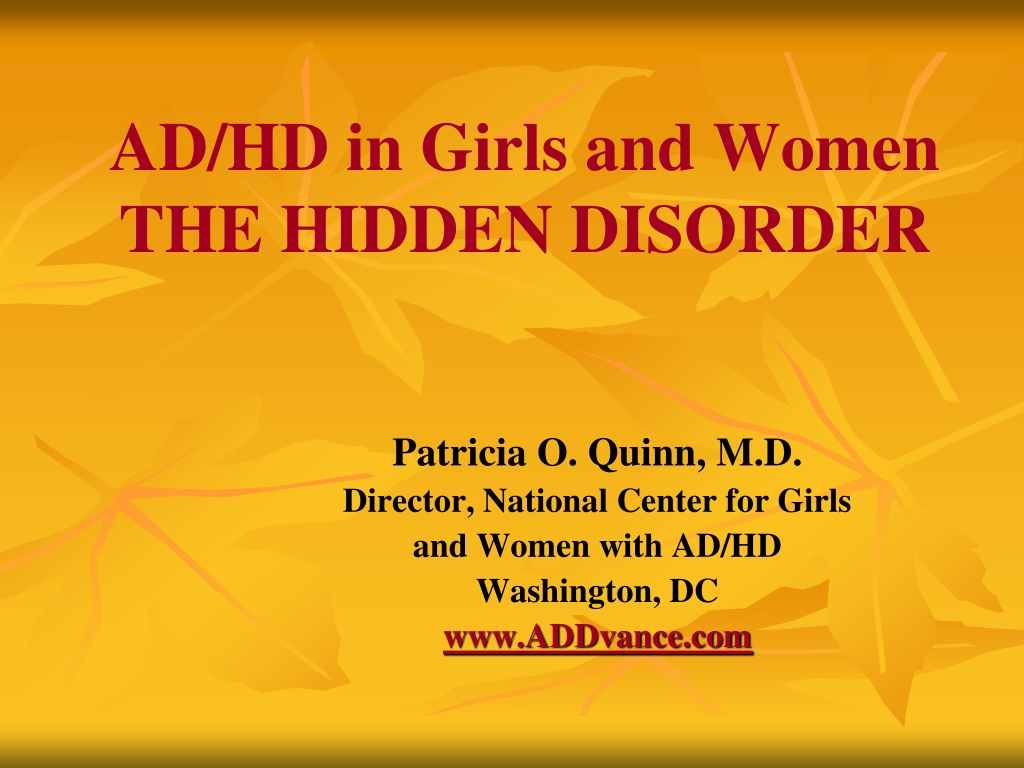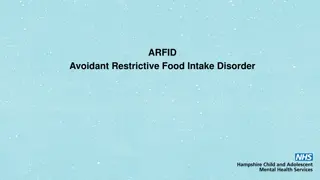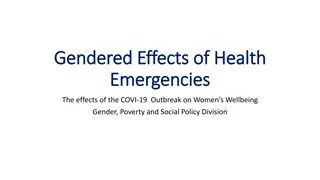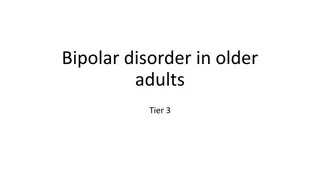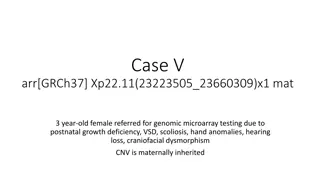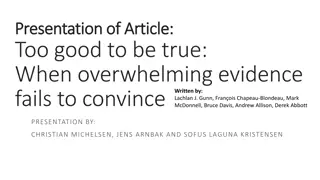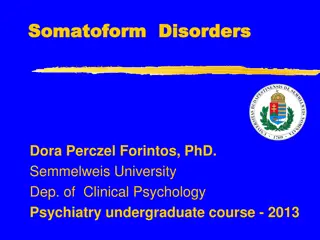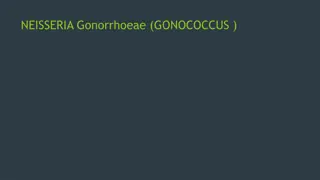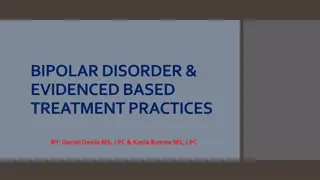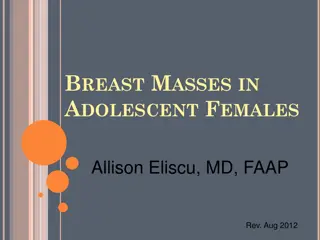Understanding AD/HD in Females: The Hidden Disorder Impacting Women's Health
Unveil the hidden impact of AD/HD on females with a focus on differences, internalizing patterns, and mitigating circumstances that often lead to underdiagnosis. Learn how undiagnosed AD/HD affects millions of women, influencing various aspects of their lives from relationships to health conditions.
Download Presentation

Please find below an Image/Link to download the presentation.
The content on the website is provided AS IS for your information and personal use only. It may not be sold, licensed, or shared on other websites without obtaining consent from the author. Download presentation by click this link. If you encounter any issues during the download, it is possible that the publisher has removed the file from their server.
E N D
Presentation Transcript
AD/HD in Girls and Women THE HIDDEN DISORDER Patricia O. Quinn, M.D. Director, National Center for Girls and Women with AD/HD Washington, DC www.ADDvance.com
Historical Impact on Gender Issues What we looked at and What we looked for pre-determined what we found
AD/HD IN FEMALES Separating Fact from Fiction Many similarities between the genders Phenotypic core of AD/HD symptoms similar to what has been observed in boys. Recent findings stress the severity of disorder in females More mood and anxiety disorders, less conduct disorder Preponderance of inattentive symptoms
How are differences manifested? Self-blame, self-attribution Low self-esteem, Demoralization, Which moves into anxiety and depression
Need to Rethink AD/HD in Females Not as a behavior disorder More as a life management disorder In males, much of focus is on how they affect OTHERS In females, we need to focus on how SHE is affected
Need to investigate internalizing patterns Internalizing patterns require much closer observation Require self-report most questionnaires are other s report
Mitigating Circumstances (especially important in understanding why girls go undiagnosed) Fewer AD/HD symptoms Structured environment High SES No ODD or CD High IQ Social pressure/need for approval
Why Learn about AD/HD in Women? Undiagnosed AD/HD is a Significant Health Concern 2nd most common psychological problem in adults Affects 4 million women - most undiagnosed Accidents/injuries Abuse Marital difficulties/sexual issues Unplanned pregnancies Parenting problems child with AD/HD Poor self-esteem/depression/anxiety Chronic stress disorders/fibromyalgia Sleep disorders Eating disorders
Outcomes of Chronic Stress Chronic stress takes its toll physically and psychologically Chronic anxiety or depression AD/HD causes stress for the entire family Spouses less tolerant of wife s AD/HD Fibromyalgia Eating disorders Chronic sleep deprivation
Consequences of Late Diagnosis In Women Depressive symptoms More stressed and anxious More external locus of control Lower self-esteem Emotion-oriented vs. task-oriented coping More psychological distress Rucklidge & Kaplan, 1997; Katz et al, 1998
Depression Most common prior diagnosis is depression Treatment for depression didn t lessen disorganization and overwhelm Bipolar disorder Primary or secondary coexisting condition?
Girls Are More Likely To Say They Took Medication For Depression Before Taking Medication For AD/HD N=161 Boys 5% N=56 Girls 14% BASE: Takes medicine to treat AD/HD Q1515 (Children): Did you take medicine for any of the following conditions before you started taking AD/HD/AD/HD medicine?
Hormones and AD/HD in Women
Estrogen and the Brain The brain is a target organ for estrogen Estrogen has a profound effect on mood, mental states, and memory by acting on both monoamine and neurotransmitter mechanisms Whenever estrogen falls below the minimum brain estrogen requirement brain dysfunction may result
Symptoms shared by women in low estrogen states Depression Sleep disturbance Irritability Anxiety Panic Memory deficits Cognitive dysfunction
Hormonal Influence on AD/HD in Women Puberty Increase in symptoms PMS Increased severity Responds to SSRIs Menopause Cognitive impairments Hormone Replacement Therapy Pros and Cons
PMS and PMDD New symptoms 75% of women experience some symptoms 10% severe enough to seek treatment PMDD-extreme mood and behavior symptoms Premenstrual magnification Cause - estrogen receptor sensitivity and fluctuating levels of neurotransmitters SSRI - 90% effective
Estrogen & Amphetamine Response in Females Justice & deWit, 1999, 2000 Two studies: 1- Pre-treatment with estradiol patches increased effect of 10 mg of amphetamine in follicular phase 2- 15 mg amphetamine administered during follicular and luteal phases - response greater during follicular phase showing response related to levels of estrogen
The AD/HD/ED connection is not difficult to understand. However, it is only within the last few years that the connection has been made and that certain individuals have called attention to this link. While Dr. Nadeau and I became interested in AD/HD and ED in 1998, it was the work of Carolyn Piver Dukarm, MD that laid the groundwork for a greater understanding of both the diagnosis and treatment of ED in those with AD/HD. Much of this presentation is based on her work and book, Pieces of a Puzzle: The Link between Eating Disorders and AD/HD (Advantage Books, 2006)
Individuals with AD/HD overeat for many reasons including: Feeling out of control and stressed by AD/HD symptoms Stimulation (when bored) Lack of control (once they start they can t stop) Lack of awareness of how much or why they are eating From Dukarm, Pieces of a Puzzle, 2006
In January 1998, AD/HDvance Magazine, co-published and co-edited by the Patricia Quinn, M.D., AND Kathleen Nadeau, Ph.D. sent readers an informal survey asking about problems of over-eating and eating disorders. The women who responded N=65 (ages 20 through 62) did not report a high incidence of eating disorders such as anorexia or bulemia, but did report problems with binge eating and compulsive over-eating.
Results of survey Binge eating: 92% of women under 40 and 78% of women over 40 Purging: 25% Under 40; 12% over 40 Anorexia: 1/24 under 40; 1/41 over 40
Many women described a pattern of eating carbohydrates (sweets and starchy snacks) in the evening, not only as a means of reward, but also as a means self-calming or "self-medication
More younger women (under 40) take stimulants 83% vs. 73% for those over 40 Younger women report stimulants are more helpful in controlling their impulsive eating patterns
In 2002 in an unpublished pilot study, Dr. John Fleming described an investigation that he conducted at the Nutritional Disorders Clinic in Toronto, Ontario. While many clients who were self-referred to the clinic benefited from the weight reduction treatment program, there was a significant group that improved in some areas such as mood and energy level, but who could not lose weight easily and could not sustain dietary or lifestyle changes for longer than a few weeks.
Dr. Fleming studied a group of 50 clients who fell into this category. They did not meet the criteria for either anorexia or bulimia, but "clearly had disturbed eating habits, with typically no regularly planned meals or snacks, and an inability to follow dietary plans for any useful length of time." (p. 412 Gender Issues and AD/HD). As these clients were more carefully evaluated, it became clear that the incidence of undiagnosed AD/HD (AD/HD) was very high.
In fact, Dr. Fleming reported that approximately one third of the clients at their clinic met clinical criteria for a diagnosis of AD/HD. Dr. Fleming is careful to note that this statistic does not imply that most people with AD/HD have disordered eating, but rather that there is a "sub- population of individuals with disordered eating plays a major role in the etiology and maintenance of the disorder."
Eating disorders in an attention- deficit/hyperactivity disorder adult clinical sample (2004) 86 DSM-IV AD/HD patients out of 107 self-referred adults in a specialized center for AD/HD were interviewed to evaluate the lifetime prevalence of ED and other conditions. Nine AD/HD patients had eating disorders Binge eating disorder (BED) was the most common diagnosis. The group with eating disorders presented a higher prevalence of other disorders (p=0.02). No significant differences were found on gender, age at assessment, schooling level and type of AD/HD.
CONCLUSIONS: AD/HD clinical samples may have a high prevalence of Binge Eating Disorder comorbidity. Patients with AD/HD and eating disorders may have a different comorbid profile.
Associations among overeating, overweight, and attention deficit/hyperactivity disorder This study used structural equation modeling (SEM) in a sample of healthy adult women to test the predictions that AD/HD symptoms predict aspects of overeating, including binge eating and emotionally-induced eating, which in turn are positively correlated with Body Mass Index. Davis, C., et al Eating Behavior. 2006; 7(3):266-74
Bulimia Nervosa and AD/HD: A Possible Role for Stimulant Medication 6 patients coexisting bulimia and AD/HD Treated with dextroamphetamine All 6 reported complete abstinence from binge eating after treatment None discontinued treatment because of side effects Dukarm, C. Journal of Women s Health. 2005. 14: 345-350.
Association between attention-deficit/hyperactivity disorder and bulimia nervosa: analysis of 4 case-control studies BACKGROUND: Impulsivity is a common feature of attention-deficit/hyperactivity disorder (AD/HD), and evidence suggests that impulsivity traits may be an indicator of poor prognosis for individuals with bulimia nervosa. To identify whether there is an association between AD/HD and bulimia nervosa, the authors systematically examined data from children and adults with and without AD/HD. METHOD: Systematic identification of the rates of bulimia nervosa in individuals with and without AD/HD (DSM-III-R criteria) in 2 large pediatric and 2 large adult samples (N = 522 children, 742 adults). Subjects were assessed from the late 1980s to February 1999. J Clin Psychiatry. 2006; 67(3):351-4 (ISSN: 0160-6689) Surman CB; Randall ET; Biederman J Clinical and Research Program in Pediatric Psychopharmacology at Massachusetts General Hospital and Harvard Medical School, Boston, Mass, USA.
RESULTS: In the 2 samples of adults with and without AD/HD, significantly greater rates of bulimia nervosa were identified in women with versus without AD/HD (12% vs. 3%, p < .05 for 1 sample and 11% vs. 1%, p < .05 for the other sample). No significant differences in rates of bulimia nervosa were identified in men or children with AD/HD when compared to sex-matched control subjects. CONCLUSION: Although preliminary and requiring further confirmation, these findings suggest that AD/HD may be associated with bulimia nervosa in some women. If confirmed, this association between bulimia nervosa and AD/HD could have important clinical and therapeutic implications.
Eating Pathology Among Adolescent Girls with Attention Deficit Disorder N= 93 adolescent girls with AD/HD-C type; 49 with AD/HD-I type and 88 Controls Girls with AD/HD-C showed more eating pathology at 5 year follow-up Baseline impulsivity symptoms best predicted adolescent eating pathology Peer rejection and parent-child relationship patterns also were predictive Mikami, Hinshaw, Peterson, & Lee Journal of Abnormal Psychology, 2008,117: 225-235.
Parents reported 8% of girls with AD/HD-C had engaged in binge eating (1% purging) 6% AD/HD-C and 5% AD/HD-I self- evaluation compared to 0% of controls unduly influenced by weight and shape
Self-Report 10% AD/HD-C surpassed clinical cut off score of 20 on the EAT as compared to 0% for AD/HD-I and Controls 9% of AD/HD-C >90 percentile for national age norms on the Drive for Thinness, Bulimia, and/or Body Dissatisfaction subscales compared to 2% for AD/HD-I and 0% of controls
Internalizing problems were significantly correlated with desire to lose weight and eating pathology
We now know that multifactorial treatment approaches are essential for both eating disorders and AD/HD to AD/HDress the complex nature of these conditions and optimize outcomes for those suffering from the dual diagnosis. The potential role of AD/HD treatment in the management of bulimia has only recently been described. From Dukarm, Pieces of a Puzzle, 2006
Why would you use AD/HD treatments to manage eating disorders? The rationale for using AD/HD treatment is two-fold First, the symptom of binge eating may result from impulsivity, and therefore decreasing impulsivity in bulimia through the use of AD/HD medication could potentially decrease binge eating and purging. From Dukarm, Pieces of a Puzzle, 2006
Secondly, appetite suppression is often observed with the use of stimulants and can result in a decrease in the desire to binge eat. The appetite suppressing effects of stimulants in individuals with bulimia commonly helps to control binge eating impulses without affecting normal appetite. From Dukarm, Pieces of a Puzzle, 2006
How does treating AD/HD symptoms help an eating disorder? Treating AD/HD symptoms can help by Decreasing impulsivity Decreasing distractibility Increasing attention span From Dukarm, Pieces of a Puzzle, 2006
Decreasing impulsivity can: Decrease binge eating Improve food choices Decrease use of food as a reward Make eating feel safer (more in control) Decrease self-medication with food From Dukarm, Pieces of a Puzzle, 2006
Decreasing distractibility can: Increase ability to follow a meal plan Increase ability to accurately report food intake and estimate portion size Decrease internal running conversation regarding food and weight Decrease stimulation seeking through food Improve ability to establish life goals and stay on track From Dukarm, Pieces of a Puzzle, 2006
Improving attention can: Improve awareness of internal cues including hunger/satiety, moods, tiredness Encourage more structured eating to prevent hypoglycemia (low blood sugar) and excess hunger Improve focus in academic/work areas and therefore increase self-confidence Improve ability to focus on other interests and therefore decrease time and attention spent focusing on one s eating disorder. From Dukarm, Pieces of a Puzzle, 2006
How to eliminate self- medication with food
Use distraction to your advantage Distraction, or the propensity to pay attention to too many things at the same time, is one of the disadvantages of having AD/HD. It can pull you away from the tasks at hand and cause frustration. However, you can use distraction to your advantage. After eating, many people with coexisting AD/HD and eating disorders tend to overfocus on the food and calories they consumed resulting in anxiety and stress. Utilize your natural tendency to shift attention by allowing some other topic or activity to catch your attention after meals and move away from the overfocus on food. From Dukarm, Pieces of a Puzzle, 2006
Get enough stimulation People with AD/HD thrive on stimulation. Get real stimulation from enjoyable activities and relationships, not artificial stimulation from food. Notice the times during the day when you are eating out of boredom ( stimulation seeking ) thus putting yourself at risk for binge eating. Arrange your schedule to maximize interesting, stimulating activities at such vulnerable times. Don t use food as a stimulant or as a reward. From Dukarm, Pieces of a Puzzle, 2006
Brief Discussion Sleep Disorders Marital and Sexuality Issues Parenting Issues
